A Nonlinear Wind Turbine Wake Expansion Model Considering Atmospheric Stability and Ground Effects
Abstract
:1. Introduction
2. Effects of the Ground on the Wind Turbine Wake Expansion
2.1. FullRF Turbulence Model for Wake Modeling
2.1.1. Turbulence Modeling
2.1.2. Boundary Conditions
2.2. Model Validation
2.2.1. Test Case
2.2.2. Computational Domain, Meshing, and Solver Settings
2.2.3. Results
2.3. Effects of the Ground on Wake Expansion
3. Typical Engineering Wake Models with Linear Wake Expansion
3.1. A Modified Jensen Model Considering Atmospheric Stability Conditions
3.2. Guassian-Shaped Wake Models
3.3. Estimation of the Streamwise Turbulence Intensity at Hub Height
4. The Proposed Engineering Wake Expansion Model
4.1. Wake Model Development Data Set
4.1.1. The Training Dataset
4.1.2. Validation Data
4.2. The LogIu Engineering Wake Model
5. Validation and Evaluation of the LogIu Wake Expansion Model
5.1. Wind Tunnel Experiment Validation
5.2. Field Observation Experiment Validation
5.2.1. Neutral Conditions
5.2.2. Non-Neutral Conditions
5.3. Overall Model Evaluation
6. Conclusions
Author Contributions
Funding
Data Availability Statement
Conflicts of Interest
References
- Chamorro, L.P.; Port-Agel, F. Effects of Thermal Stability and Incoming Boundary-Layer Flow Characteristics on Wind-Turbine Wakes: A Wind-Tunnel Study. Bound.-Layer Meteorol. 2010, 136, 515–533. [Google Scholar] [CrossRef]
- Hancock, P.E.; Pascheke, F. Wind-tunnel simulation of the wake of a large wind turbine in a stable boundary layer: Part 2, the wake flow. Bound.-Layer Meteorol. 2014, 151, 23–37. [Google Scholar] [CrossRef]
- Zhang, W.; Markfort, C.D.; Port-Agel, F. Wind-turbine wakes in a convective boundary layer: A wind-tunnel study. Bound.-Layer Meteorol. 2013, 146, 161–179. [Google Scholar] [CrossRef]
- Han, X.; Liu, D.; Xu, C.; Shen, W.Z. Atmospheric stability and topography effects on wind turbine performance and wake properties in complex terrain. Renew. Energy 2018, 126, 640–651. [Google Scholar] [CrossRef]
- Machefaux, E.; Larsen, G.C.; Koblitz, T.; Troldborg, N.; Kelly, M.C.; Chougule, A.; Hansen, K.S.; Rodrigo, J.S. An experimental and numerical study of the atmospheric stability impact on wind turbine wakes. Wind Energy 2016, 19, 1785–1805. [Google Scholar] [CrossRef]
- Foreman, R.J.; Cañadillas, B.; Robinson, N. The Atmospheric Stability Dependence of Far Wakes on the Power Output of Downstream Wind Farms. Energies 2024, 17, 488. [Google Scholar] [CrossRef]
- Peña, A.; Réthoré, P.-E.; Rathmann, O. Modeling large offshore wind farms under different atmospheric stability regimes with the Park wake model. Renew. Energy 2014, 70, 164–171. [Google Scholar] [CrossRef]
- Cheng, Y.; Zhang, M.; Zhang, Z.; Xu, J. A new analytical model for wind turbine wakes based on Monin-Obukhov similarity theory. Appl. Energy 2019, 239, 96–106. [Google Scholar] [CrossRef]
- Wu, Y.-T.; Port-Agel, F. Atmospheric turbulence effects on wind-turbine wakes: An LES study. Energies 2012, 5, 5340–5362. [Google Scholar] [CrossRef]
- Abkar, M.; Port-Agel, F. Influence of Atmospheric Stability on Wind-Turbine Wakes: A Large-Eddy Simulation Study. Phys. Fluids 2015, 27, 035104. [Google Scholar] [CrossRef]
- Gao, X.; Li, B.; Wang, T.; Sun, H.; Yang, H.; Li, Y.; Wang, Y.; Zhao, F. Investigation and validation of 3D wake model for horizontal-axis wind turbines based on filed measurements. Appl. Energy 2020, 260, 114272. [Google Scholar] [CrossRef]
- Huanqiang, Z.; Xiaoxia, G.; Hongkun, L.; Qiansheng, Z.; Xiaoxun, Z.; Yu, W.; Fei, Z. Investigation of a new 3D wake model of offshore floating wind turbines subjected to the coupling effects of wind and wave. Appl. Energy 2024, 365, 123189. [Google Scholar] [CrossRef]
- Ling, Z.; Zhao, Z.; Liu, Y.; Liu, H.; Liu, Y.; Ma, Y.; Wang, T.; Wang, D. A three-dimensional wake model for wind turbines based on a polynomial distribution of wake velocity. Ocean Eng. 2023, 282, 115064. [Google Scholar] [CrossRef]
- Wang, Z.; Yang, X. Upward Shift of Wind Turbine Wakes in Large Wind Farms. Energies 2023, 16, 8051. [Google Scholar] [CrossRef]
- Chamorro, L.P.; Porté-Agel, F. A Wind-Tunnel Investigation of Wind-Turbine Wakes: Boundary-Layer Turbulence Effects. Bound.-Layer Meteorol. 2009, 132, 129–149. [Google Scholar] [CrossRef]
- Han, X.; Liu, D.; Xu, C.; Shen, W.; Li, L.; Xue, F. Monin–Obukhov Similarity Theory for Modeling of Wind Turbine Wakes under Atmospheric Stable Conditions: Breakdown and Modifications. Appl. Sci. 2019, 9, 4256. [Google Scholar] [CrossRef]
- Drela, M. XFOIL: An analysis and design system for low Reynolds number airfoils. In Low Reynolds Number Aerodynamics; Springer: Berlin/Heidelberg, Germany, 1989; pp. 1–12. [Google Scholar]
- Du, Z.; Selig, M. A 3-D stall-delay model for horizontal axis wind turbine performance prediction. In Proceedings of the 1998 ASME Wind Energy Symposium, Reno, NV, USA, 12–15 January 1998; pp. 9–19. [Google Scholar]
- Shen, W.Z.; Zhu, W.J.; Sørensen, J.N. Actuator line/Navier–Stokes computations for the MEXICO rotor: Comparison with detailed measurements. Wind Energy 2012, 15, 811–825. [Google Scholar] [CrossRef]
- Shen, W.Z.; Mikkelsen, R.; Sørensen, J.N.; Bak, C. Tip loss corrections for wind turbine computations. Wind Energy 2005, 8, 457–475. [Google Scholar] [CrossRef]
- Alinot, C.; Masson, C. k-ε Model for the Atmospheric Boundary Layer Under Various Thermal Stratifications. J. Sol. Energy Eng. 2005, 127, 438–443. [Google Scholar] [CrossRef]
- van der Laan, M.P.; Kelly, M.C.; Srensen, N.N. A new k-epsilon model consistent with Monin--Obukhov similarity theory. Wind Energy 2017, 20, 479–489. [Google Scholar] [CrossRef]
- Temel, O.; van Beeck, J. Two-equation eddy viscosity models based on the Monin-Obukhov similarity theory. Appl. Math. Model. 2017, 42, 1–16. [Google Scholar] [CrossRef]
- Chang, C.-Y.; Schmidt, J.; Drenkmper, M.; Stoevesandt, B. A consistent steady state CFD simulation method for stratified atmospheric boundary layer flows. J. Wind Eng. Ind. Aerodyn. 2018, 172, 55–67. [Google Scholar] [CrossRef]
- Businger, J.A.; Wyngaard, J.C.; Izumi, Y.; Bradley, E.F. Flux-profile relationships in the atmospheric surface layer. J. Atmos. Sci. 1971, 28, 181–189. [Google Scholar] [CrossRef]
- Dyer, A.J. A review of flux-profile relationships. Bound.-Layer Meteorol. 1974, 7, 363–372. [Google Scholar] [CrossRef]
- Zhang, X. CFD Simulation of Neutral ABL Flows; Risø National Laboratory: Roskilde, Denmark, 2009. [Google Scholar]
- Sørensen, J.N.; Mikkelsen, R.F.; Henningson, D.S.; Ivanell, S.; Sarmast, S.; Andersen, S.J. Simulation of wind turbine wakes using the actuator line technique. Philos. Trans. R. Soc. A Math. Phys. Eng. Sci. 2015, 373, 20140071. [Google Scholar] [CrossRef] [PubMed]
- Weller, H.G.; Tabor, G.; Jasak, H.; Fureby, C. A tensorial approach to computational continuum mechanics using object-oriented techniques. Comput. Phys. 1998, 12, 620–631. [Google Scholar] [CrossRef]
- Jensen, N.O. A Note on Wind Generator Interaction; Risø National Laboratory: Roskilde, Denmark, 1983. [Google Scholar]
- Barthelmie, R.J.; Hansen, K.S.; Frandsen, S.T.; Rathmann, O.; Schepers, J.G.; Schlez, W.; Phillips, J.; Rados, K.; Zervos, A.; Politis, E.S.; et al. Modelling and measuring flow and wind turbine wakes in large wind farms offshore. Wind Energy 2009, 12, 431–444. [Google Scholar] [CrossRef]
- Gmen, T.; Van der Laan, P.; Rthor, P.-E.; Diaz, A.P.; Larsen, G.C.; Ott, S. Wind turbine wake models developed at the technical university of Denmark: A review. Renew. Sustain. Energy Rev. 2016, 60, 752–769. [Google Scholar]
- Peña, A.; Réthoré, P.E.; van der Laan, M.P. On the application of the Jensen wake model using a turbulence-dependent wake decay coefficient: The Sexbierum case. Wind Energy 2016, 19, 763–776. [Google Scholar] [CrossRef]
- Bastankhah, M.; Port-Agel, F. A new analytical model for wind-turbine wakes. Renew. Energy 2014, 70, 116–123. [Google Scholar] [CrossRef]
- Johnson, P.B.; Jonsson, C.; Achilleos, S.; Eames, I. On the spread and decay of wind turbine wakes in ambient turbulence. J. Phys. Conf. Ser. 2014, 555, 012055. [Google Scholar] [CrossRef]
- Bastankhah, M.; Port-Agel, F. Experimental and theoretical study of wind turbine wakes in yawed conditions. J. Fluid Mech. 2016, 806, 506–541. [Google Scholar] [CrossRef]
- Carbajo Fuertes, F.; Markfort, C.; Port-Agel, F. Wind turbine wake characterization with nacelle-mounted wind lidars for analytical wake model validation. Remote Sens. 2018, 10, 668. [Google Scholar] [CrossRef]
- Campagnolo, F.; Molder, A.; Schreiber, J.; Bottasso, C.L. Comparison of Analytical Wake Models with Wind Tunnel Data. J. Phys. Conf. Ser. 2019, 1256, 012006. [Google Scholar] [CrossRef]
- ESDU 85020; Characteristics of Atmospheric Turbulence Near the Ground. Part II: Single Point Data for Strong Winds (Neutral Atmosphere). Engineering Sciences Data Unit: London, UK, 2001. Available online: https://www.esdu.com/cgi-bin/ps.pl?t=doc&p=esdu_85020g (accessed on 18 August 2024).
- Dou, B.; Guala, M.; Lei, L.; Zeng, P. Experimental investigation of the performance and wake effect of a small-scale wind turbine in a wind tunnel. Energy 2019, 166, 819–833. [Google Scholar] [CrossRef]
- Dou, B.; Guala, M.; Lei, L.; Zeng, P. Wake model for horizontal-axis wind and hydrokinetic turbines in yawed conditions. Appl. Energy 2019, 242, 1383–1395. [Google Scholar] [CrossRef]
- Bastankhah, M.; Port-Agel, F. A new miniature wind turbine for wind tunnel experiments. Part ii: Wake structure and flow dynamics. Energies 2017, 10, 923. [Google Scholar] [CrossRef]
- Chu, C.-R.; Chiang, P.-H. Turbulence effects on the wake flow and power production of a horizontal-axis wind turbine. J. Wind Eng. Ind. Aerodyn. 2014, 124, 82–89. [Google Scholar] [CrossRef]
- Hancock, P.E.; Zhang, S. A wind-tunnel simulation of the wake of a large wind turbine in a weakly unstable boundary layer. Bound.-Layer Meteorol. 2015, 156, 395–413. [Google Scholar] [CrossRef]
- Hancock, P.E.; Zhang, S.; Pascheke, F.; Hayden, P. Wind Tunnel Simulation of a Wind Turbine Wake in Neutral, Stable and Unstable Wind Flow. J. Phys. Conf. Ser. 2014, 555, 012047. [Google Scholar] [CrossRef]
- Pederson, B.M.; Nielson, P. Description of the two Danish 630 kW wind turbines, Nibe-A and Nibe-B, and some preliminary test results, DEFU, Denmark. In Proceedings of the Third International Symposium on Wind Energy Systems, Copenhagen, Denmark, 26–29 August 1980; pp. 223–238. [Google Scholar]
- Taylor, G.J. Wake Measurements on the Nibe Wind-Turbines in Denmark; National Power, Technology and Environment Centre: Leatherhead, UK, 1990. [Google Scholar]
- Magnusson, M.; Rados, K.G.; Voutsinas, S.G. A study of the flow downstream of a wind turbine using measurements and simulations. Wind Eng. 1996, 20, 389–403. [Google Scholar]
- Magnusson, M.; Smedman, A.-S. Influence of atmospheric stability on wind turbine wakes. Wind Eng. 1994, 18, 139–152. [Google Scholar]
- Magnusson, M.; Smedman, A.-S. Air flow behind wind turbines. J. Wind Eng. Ind. Aerodyn. 1999, 80, 169–189. [Google Scholar] [CrossRef]
- Niayifar, A.; Porté-Agel, F. Analytical modeling of wind farms: A new approach for power prediction. Energies 2016, 9, 741. [Google Scholar] [CrossRef]
- Ishihara, T.; Qian, G. A New Gaussian-Based Analytical Wake Model for Wind Turbines Considering Ambient Turbulence Intensities and Thrust Coefficient Effects. J. Wind Eng. Ind. Aerodyn. 2018, 177, 275–292. [Google Scholar] [CrossRef]
- Ge, M.; Wu, Y.; Liu, Y.; Li, Q. A two-dimensional model based on the expansion of physical wake boundary for wind-turbine wakes. Appl. Energy 2019, 233, 975–984. [Google Scholar] [CrossRef]

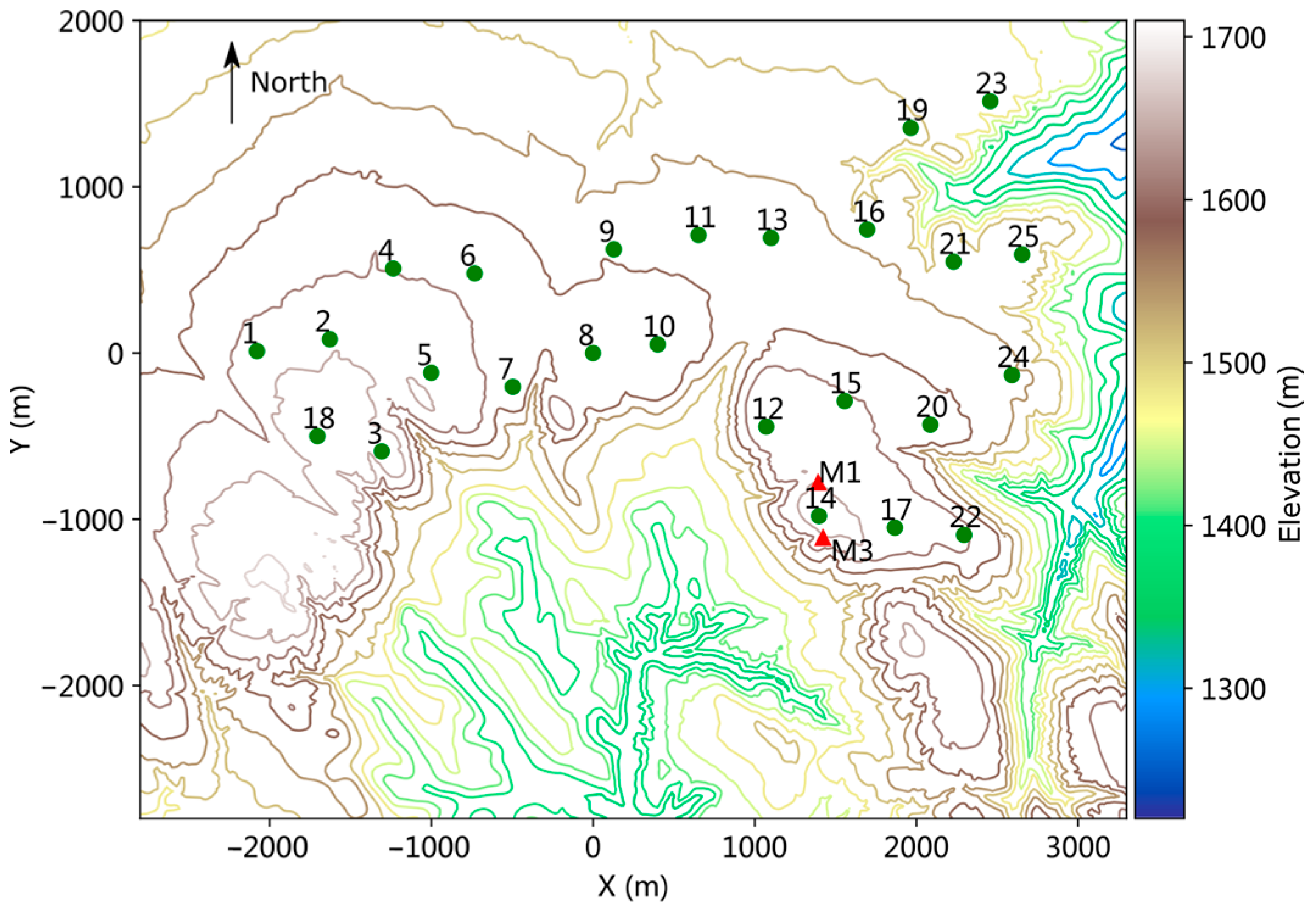
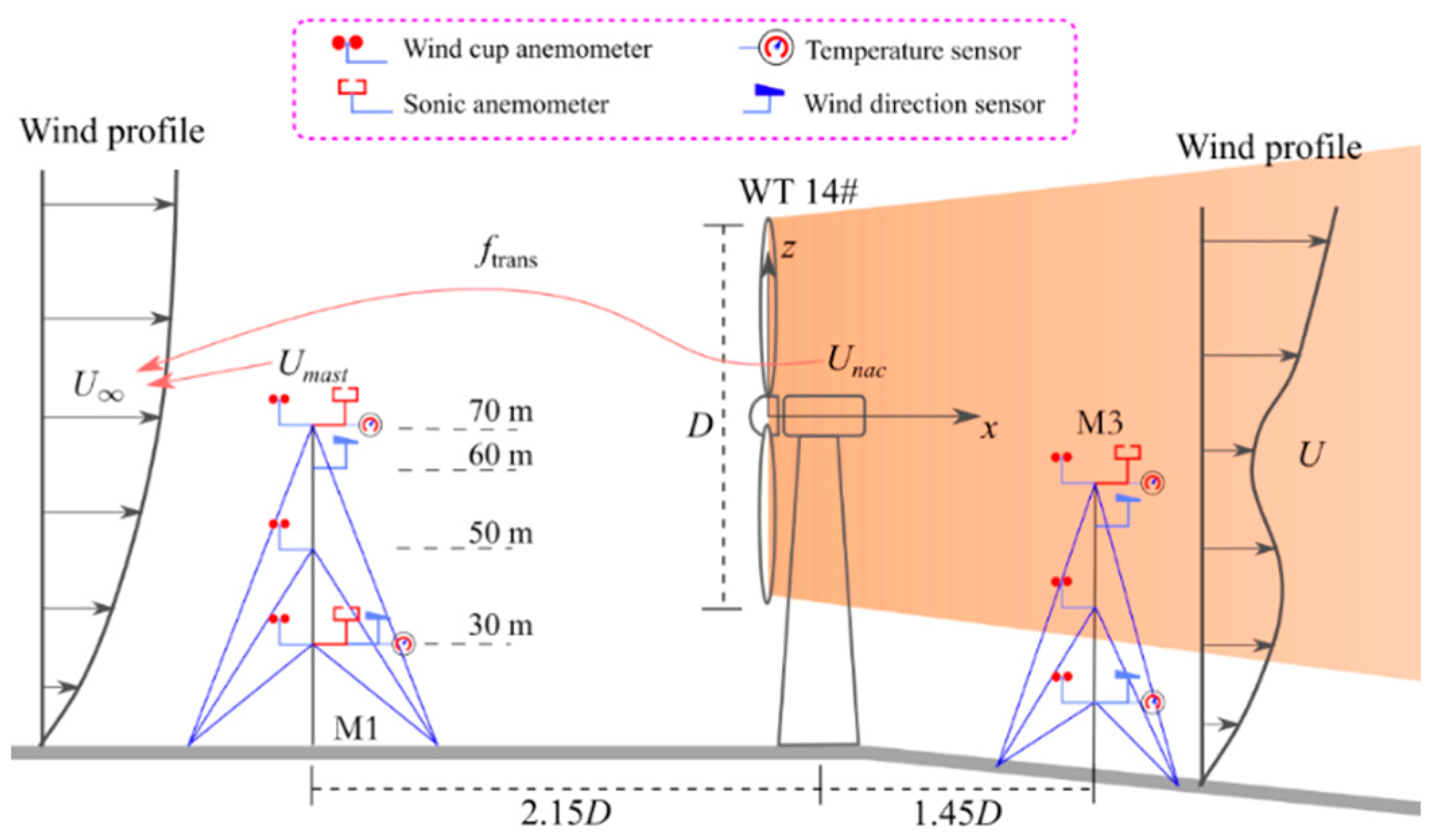
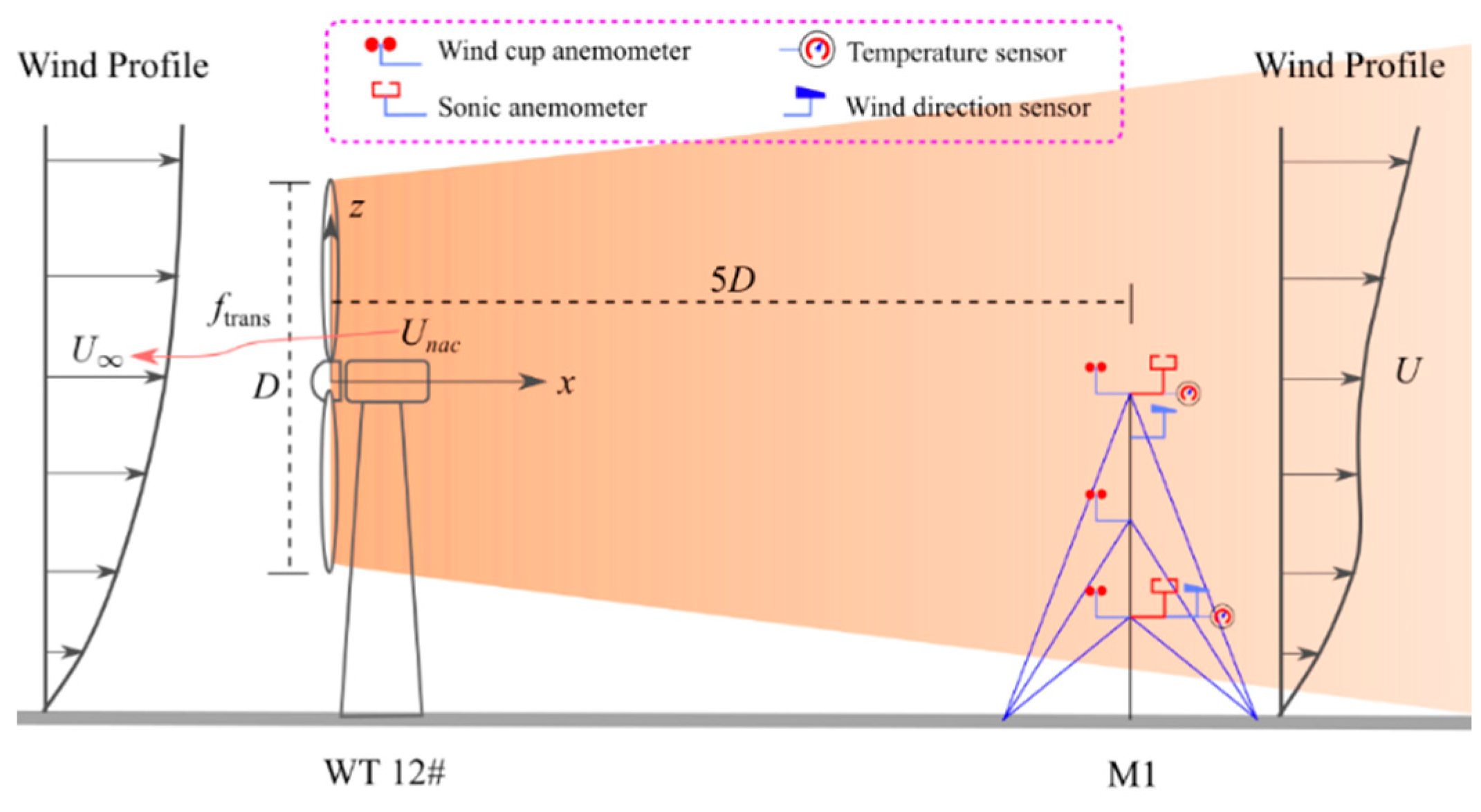
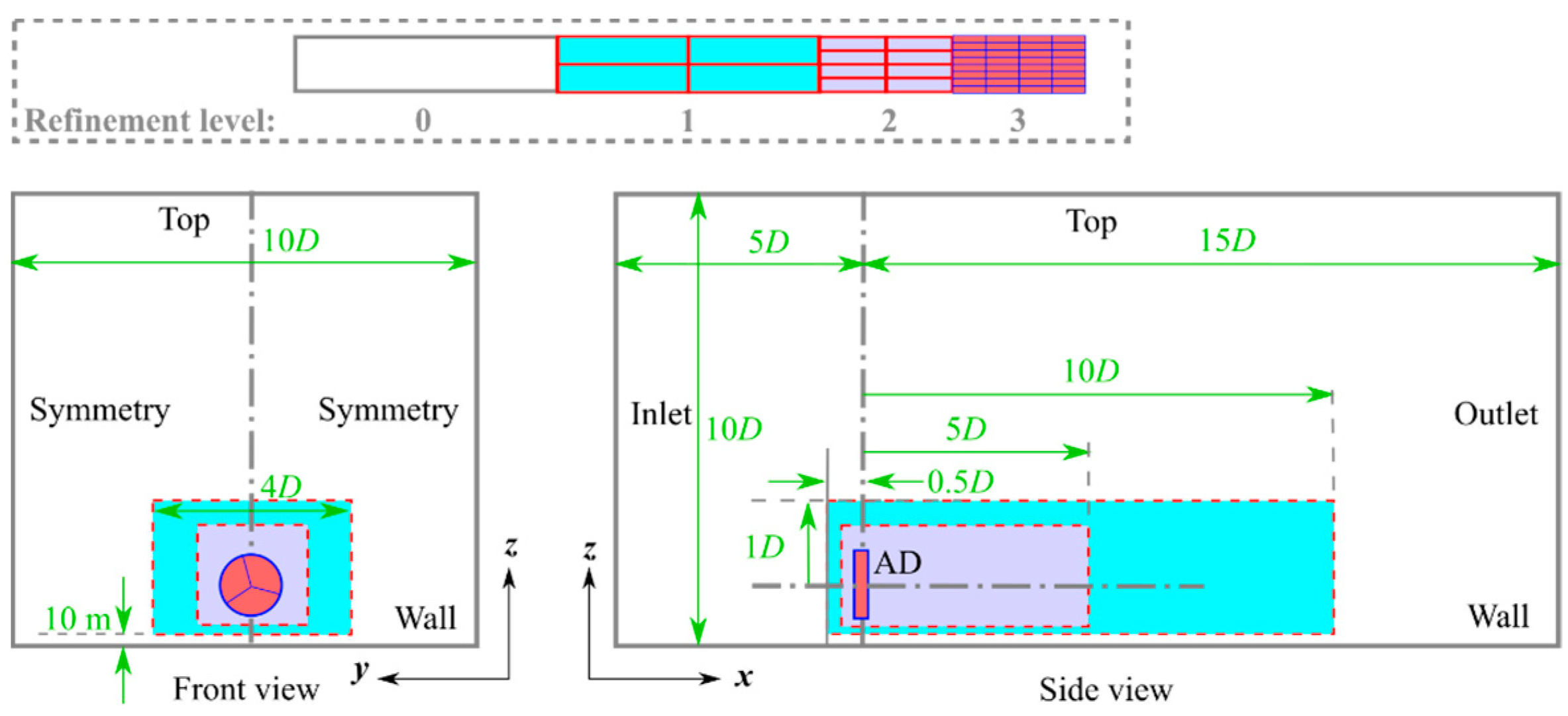


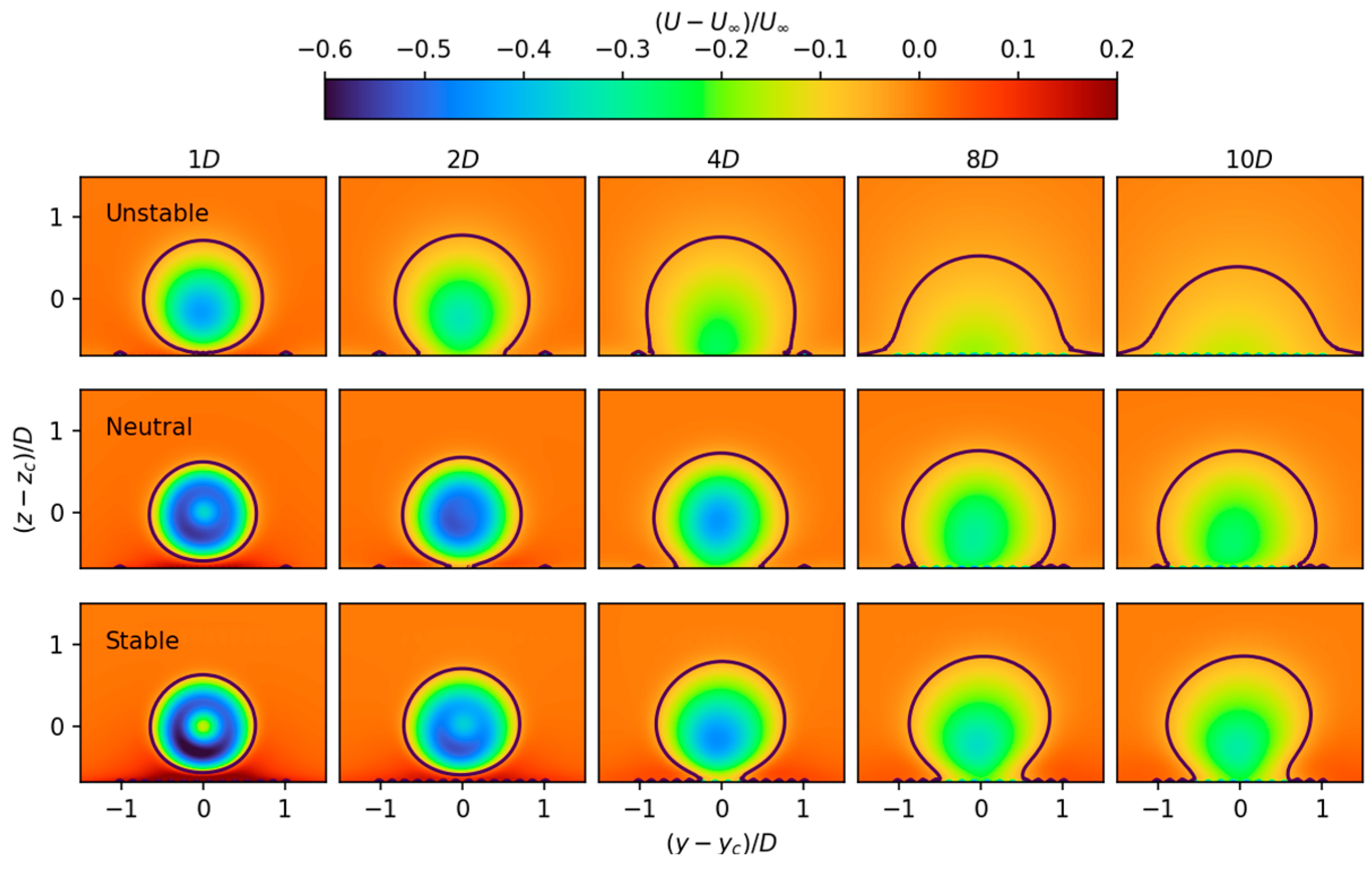
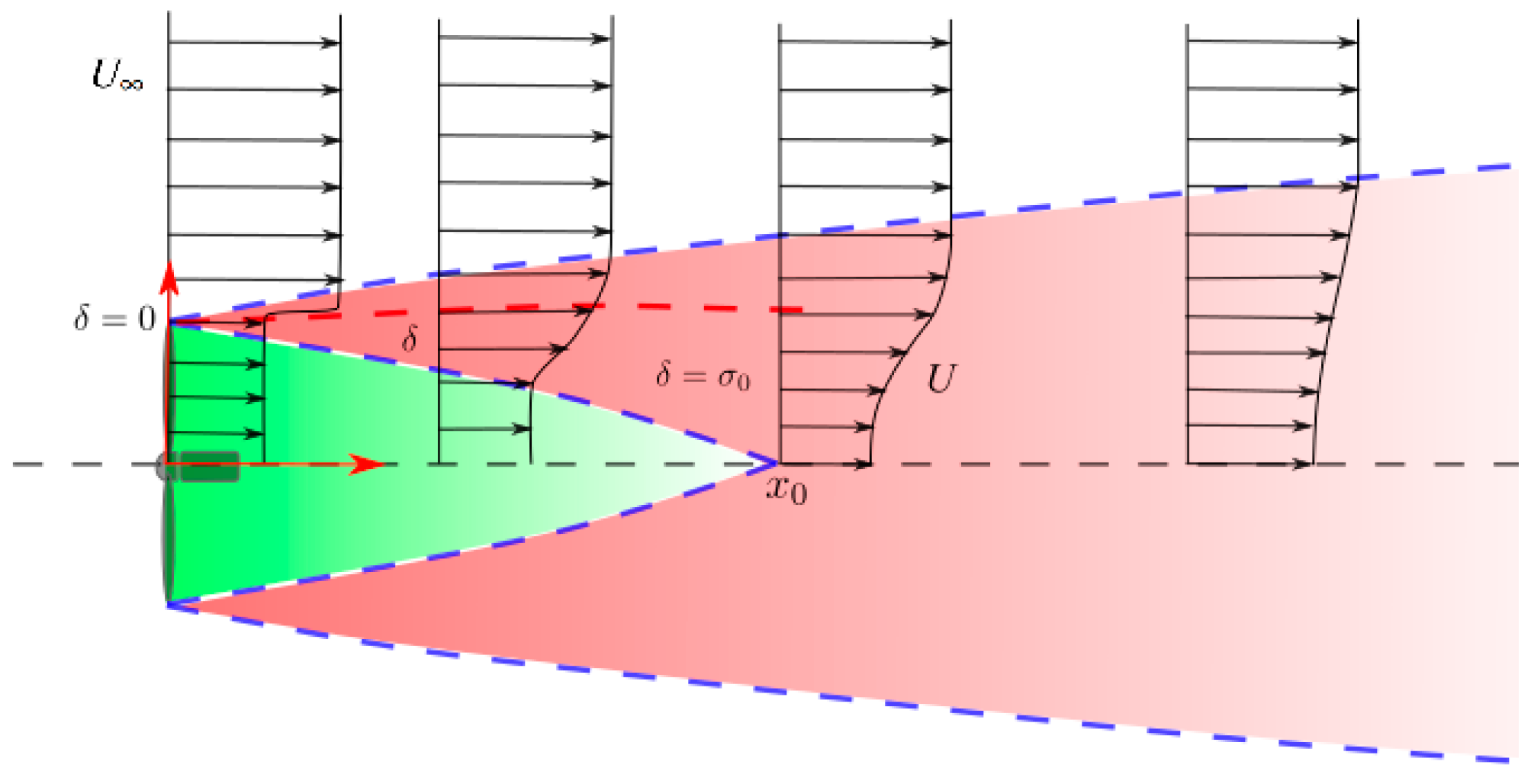
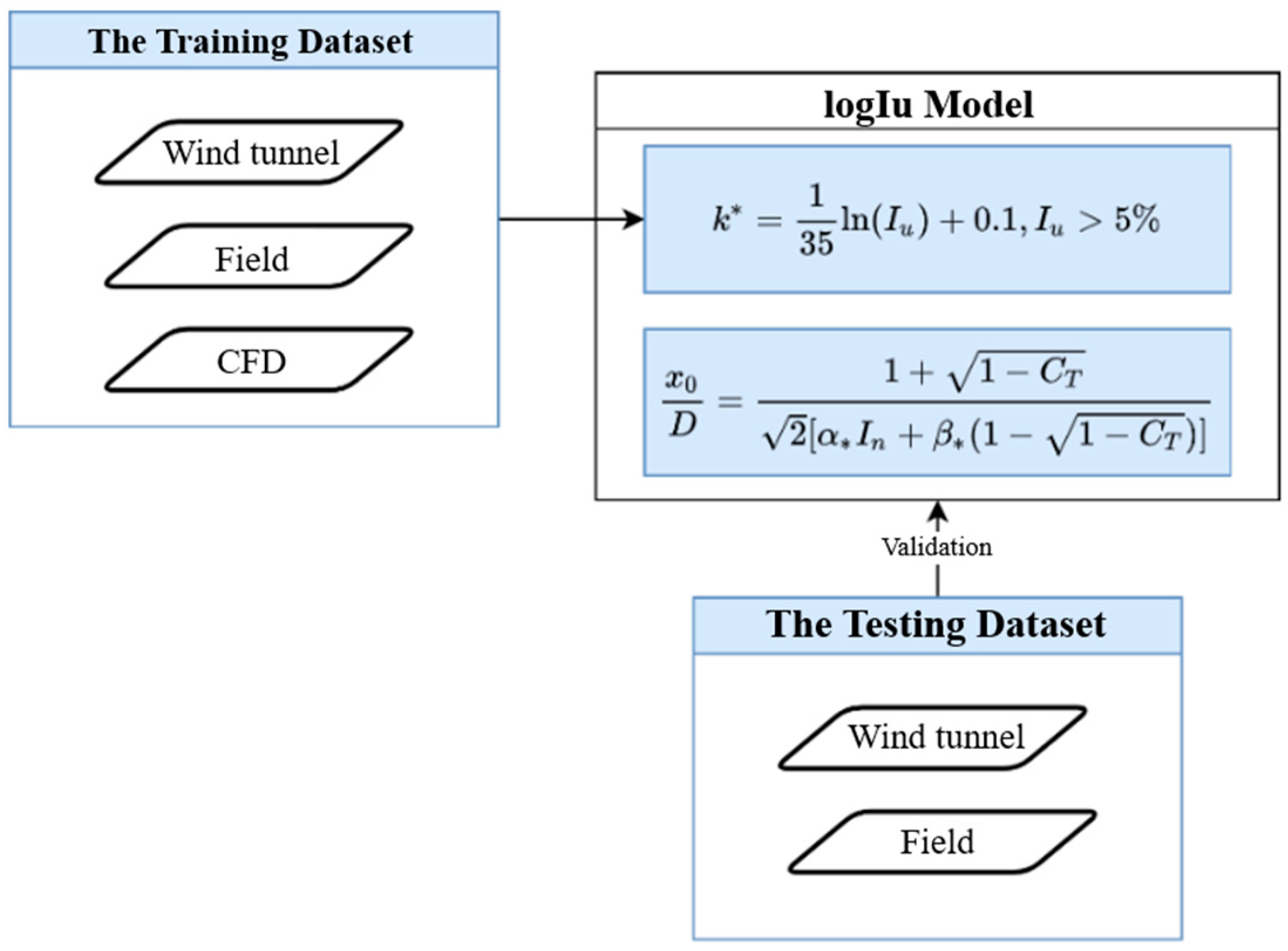
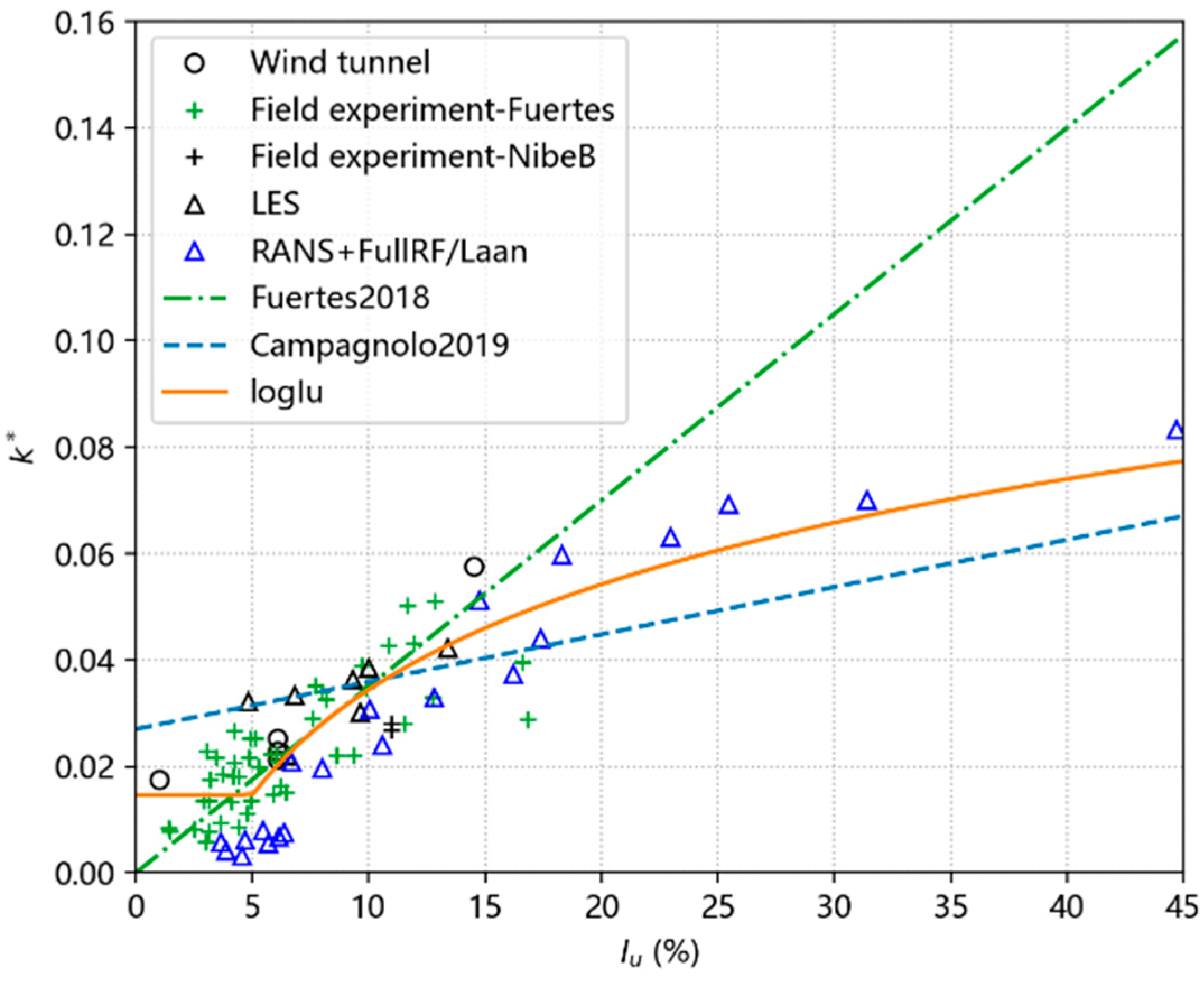

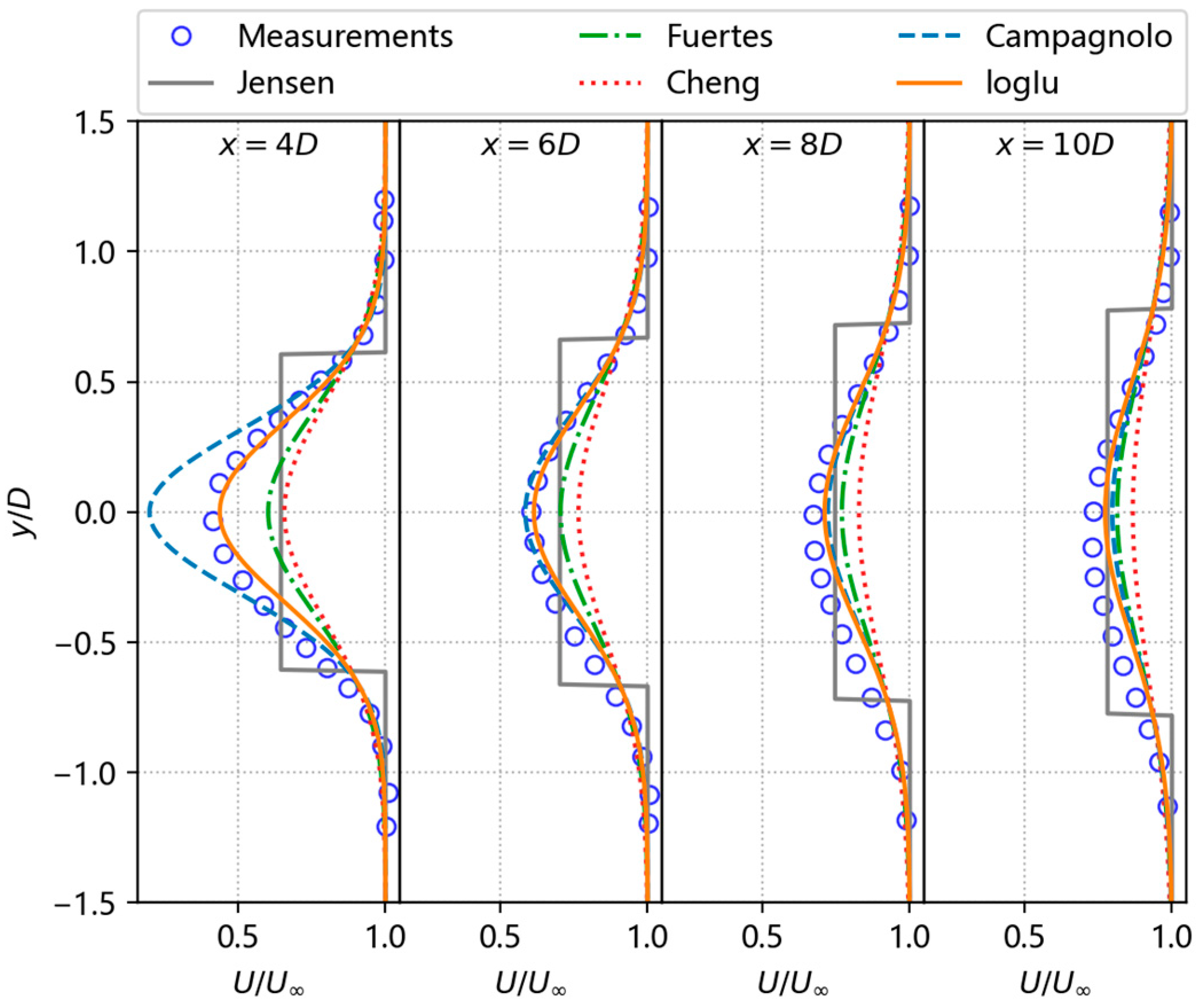

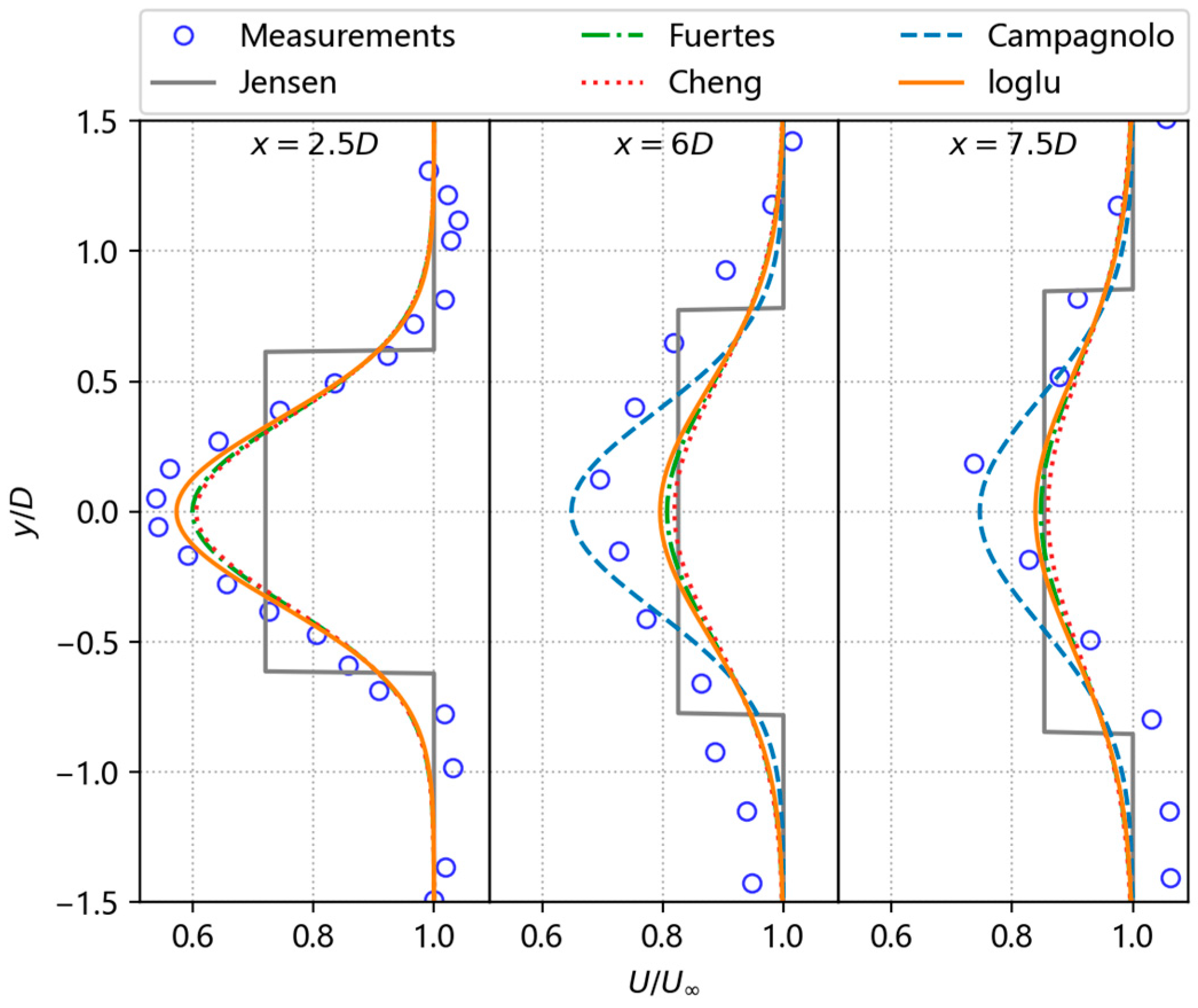
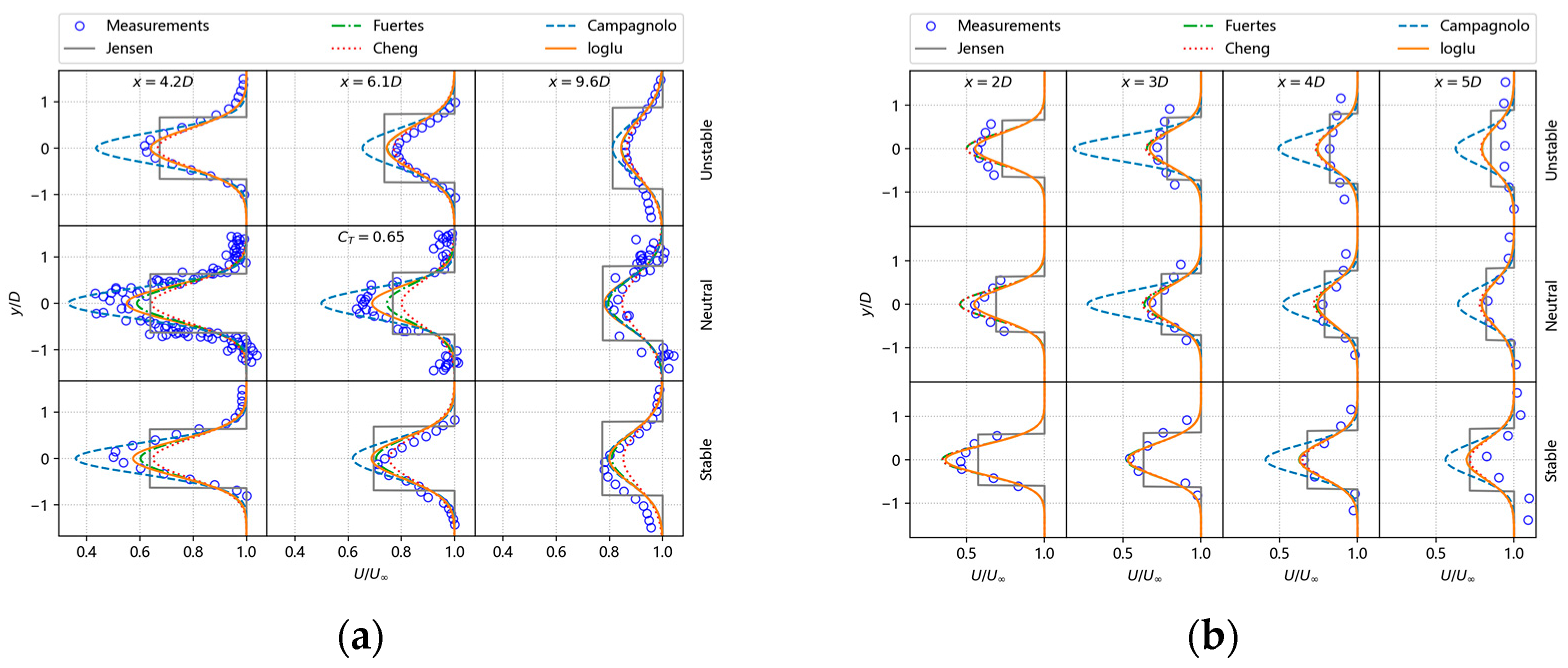
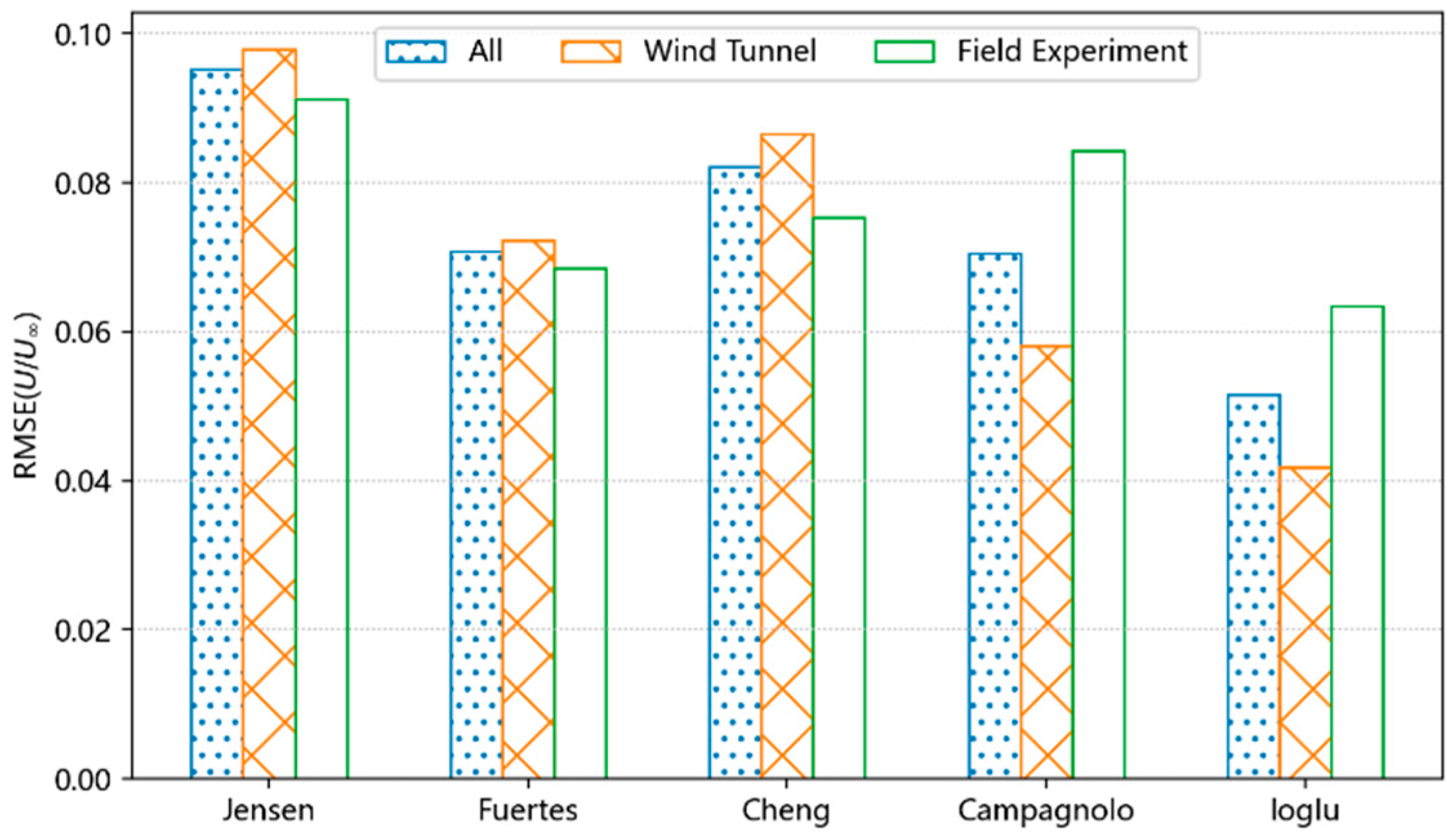

| Atmosphere Stability | (m) | (%) | (m/s) | (%) | ||
|---|---|---|---|---|---|---|
| Classical | FullRF | Classical | FullRF | |||
| Unstable | −30 | 17.6 | 0.425 | 22.8 | ||
| Neutral | 11.6 | 0.333 | 10.6 | |||
| Stable | 30 | 7.8 | 0.131 | 0.208 | 4 | 9 |
| Model | Fuertes | Cheng | Campagnolo |
|---|---|---|---|
| Scale | The experimental measurement of the nacelle lidar | Considering lateral turbulence | Wind tunnel experiment |
| Equation (33), , | |||
| Experiment Type | Cases | Subcases | D (m) | H (m) | Wake Range (D) |
|---|---|---|---|---|---|
| Wind tunnel tests | Dou2019 [40,41] | TSR = 4, 5, 6 | 0.2 | 0.75 | 4.5~10 |
| WiRE-01 [42] | / | 0.15 | 0.125 | 4~10 | |
| Ruland-913 [43] | In turbulent flows | 0.9 | 1.12 | 2.5~8.5 | |
| G1 [38] | Three offshore cases | 1.1 | 0.83 | 5~10 | |
| Hancock2014 [2,44,45] | Neutral, unstable, and stable cases | 0.416 | 0.3 | 3~10 | |
| Field experiments | Nibe-B [46,47] | = 0.67, 0.77, 0.82 | 40 | 45 | 2.5~7.5 |
| Liberty C96 [37] | / | 96 | 80 | 0.6~10 | |
| Vestas V80-2MW [9] | Neutral (LES): 4 types of z0 and three stability classes (LES) | 80 | 70 | 3~15 | |
| Danwin [48,49,50] | Neutral: = 0.65, 0.82 Non-neutral: (experiments + RANS) | 23 | 35 | 4.2~9.6 | |
| Nordtank [5] | Three stability classes (experiments + RANS) | 41 | 36 | 2~5 | |
| Haizhuang [4] | Three stability classes (experiments + RANS) | 93 | 67 | 1.45, 2.15, 5 | |
| Nibe-B [46,47] | = 0.67, 0.77,0.82 | 40 | 45 | 2.5~7.5 |
| Turbine | (m) | (m) | (m) | (%) | (10−3) |
|---|---|---|---|---|---|
| Haizhuang | 5 × 10−8 | ∞ | 0.114 | 3.6 | 5.79 |
| 5 × 10−6 | 0.146 | 4.7 | 6.28 | ||
| 5 × 10−5 | 0.17 | 5.4 | 8.07 | ||
| 0.05 | −100 | 0.382 | 16.2 | 37.47 | |
| −1000 | 0.5122 | 17.4 | 44.05 | ||
| 0.5 | −100 | 0.601 | 25.6 | 69.38 | |
| −50 | 0.655 | 31.6 | 70.13 | ||
| −20 | 0.755 | 45 | 83.43 | ||
| Nordtank | 0.2 | ∞ | 0.542 | 14.6 | 51.26 |
| Danwin | 5 × 10−4 | 35 | 0.198 | 4.5 | 3.23 |
| Training Cases | (%) | ||
|---|---|---|---|
| Wind tunnel experiments | Dou2019 (TSR = 4) | 1 | 0.85 |
| G1: offshore | 6.1 | 0.79, 0.73, 0.68 | |
| Rutland-913 | 14.5 | 0.94 | |
| Field measurements | Nibe-B | 11 | 0.77, 0.82 |
| Liberty C96 | 1.6~17 | 0.82 | |
| LES simulations | Vestas: neutral | 4.8~13.4 | 0.8 |
| Vestas: three stability classes | 6.5~10 | 0.8 | |
| RANS simulations | Haizhuang | 3.6~44.7 | 0.84 |
| Nordtank | 6.1~18.3 | 0.83 | |
| Danwin | 4.5~10 | 0.82 | |
| Case Validation | (m) | (%) | |||
|---|---|---|---|---|---|
| Wind tunnel | Dou2019 (TSR = 5, 6) | 6 | ∞ | 1 | 0.91, 0.94 |
| WIRE-01 | 5 | ∞ | 7 | ||
| Hancock2014 | 2.3, 2.3, 1.47 | 0.956, ∞, −1.26 | 8.5, 6.6, 5.3 | 0.42, 0.48, 0.48 | |
| Field | Nibe-B | 11.52 | ∞ | 10.5 | 0.67 |
| Danwin | 8, 11, 8 | −50, ∞, 90.6 | 9.7, 6, 7.6 | 0.82, 0.65, 0.82 | |
| Nordtank | 6.82, 7.03, 6.76 | −84.8, ∞, 29 | 14, 15, 10 | 0.71,0.75,0.83 | |
Disclaimer/Publisher’s Note: The statements, opinions and data contained in all publications are solely those of the individual author(s) and contributor(s) and not of MDPI and/or the editor(s). MDPI and/or the editor(s) disclaim responsibility for any injury to people or property resulting from any ideas, methods, instructions or products referred to in the content. |
© 2024 by the authors. Licensee MDPI, Basel, Switzerland. This article is an open access article distributed under the terms and conditions of the Creative Commons Attribution (CC BY) license (https://creativecommons.org/licenses/by/4.0/).
Share and Cite
Han, X.; Wang, T.; Ma, X.; Xu, C.; Fu, S.; Zhang, J.; Xue, F.; Cheng, Z. A Nonlinear Wind Turbine Wake Expansion Model Considering Atmospheric Stability and Ground Effects. Energies 2024, 17, 4503. https://doi.org/10.3390/en17174503
Han X, Wang T, Ma X, Xu C, Fu S, Zhang J, Xue F, Cheng Z. A Nonlinear Wind Turbine Wake Expansion Model Considering Atmospheric Stability and Ground Effects. Energies. 2024; 17(17):4503. https://doi.org/10.3390/en17174503
Chicago/Turabian StyleHan, Xingxing, Tongguang Wang, Xiandong Ma, Chang Xu, Shifeng Fu, Jinmeng Zhang, Feifei Xue, and Zhe Cheng. 2024. "A Nonlinear Wind Turbine Wake Expansion Model Considering Atmospheric Stability and Ground Effects" Energies 17, no. 17: 4503. https://doi.org/10.3390/en17174503
APA StyleHan, X., Wang, T., Ma, X., Xu, C., Fu, S., Zhang, J., Xue, F., & Cheng, Z. (2024). A Nonlinear Wind Turbine Wake Expansion Model Considering Atmospheric Stability and Ground Effects. Energies, 17(17), 4503. https://doi.org/10.3390/en17174503







